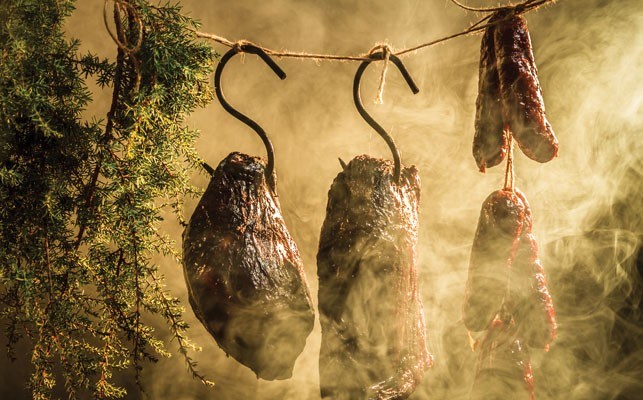That old summer refrain — hot enough for ya? — has taken on a new twist across B.C., including Sea to Sky country.
Smoky enough for ya?, or something along those lines, is the latest conversation starter as heavy smoke from Interior wildfires is sucked to the coast by weather systems acting like stubborn vacuum cleaners. Up to half of B.C. has been blanketed by smoke, something we're only going to see more of with climate change.
Kamloops has suffered its worst air quality in history. On Saturday, that region was off the scales, hitting 49 on the air quality index, which normally tops off at 10! Our usually beautiful vistas of mountaintops that anchor our sense of self and place have vanished into the smoky haze. The tops of Whistler, Blackcomb, the North Shore Mountains — gone.
When I'm not wondering how things like birds, plants and insects contend with all this smoke — honeybees react to smoke by eating lots of honey to survive but we've got some nearby mason bees we haven't seen all week — I'm dreaming up ways to make this nasty a positive. In the kitchen that means smokin' up some meat, including poultry or fish.
With all our fancy refrigeration these days, it's easy to forget that smoking was once an important way to preserve all kinds of meats. Smoke — essentially a mixture of water vapour, carbon and fine particulates — when applied correctly to fresh meats adds equal parts flavour and preservative.
Our Eastern European friends from places like Ukraine, Serbia and Poland are well acquainted with the pleasures of smoked meats, both making and enjoying them. Smoked ham, smoked herring, smoked eel, smoked sausages and smoked chicken are all popular.
Finns enjoy smoked reindeer meat called poronkieli. For Iranians, it's mahi dudi — smoked fish. Russians love smoked salmon as much as Canadians, and Slovenes like their usicka prsuta, or smoked beef. In Iceland, lamb is the staple meat, and Icelanders still enjoy a typical Sunday meal of svio, a whole head of lamb, smoked or fresh, that's boiled and served.
While experts like Big Smoke Whistler are harnessing the power of smoke to add flavour and goodness to their barbecued delights, actually smoking meat and fish is a different process altogether, a very, very old one.
Pork was a favourite of the Ancient Romans but it seems they didn't eat smoked pork, or what we know as ham, until they came across the people of the Westphalian forests in what is now Germany.
"The forests of Westphalia contained herds of pigs which roamed almost free, and were famous for the flavour of their flesh," writes Maguelonne Toussaint-Samat in her 1987 classic, History of Food. "Westphailan ham, dry-salted and then smoked, as it still is today, was very popular with the Romans and was making the fortunes of Germanic tribesman 2,000 years ago."
Today, those Westphalian pigs are still eating the acorns in the forest that gave their flesh its uniquely delicious flavour; the hams are then smoked using juniper and beechwood. Corsican hams and other charcuteries have also been traditional favourites due to acorn-eating pigs, while Basque and Rhineland hams, too, have long been popular. Traditionally, Italian pigs were brushed with olive oil before and after smoking them.
It's this final step — the smoking — that's critical to the outcome of the smoked meat product.
But first things first, for virtually all smoked meats must start with a pickling brine. Toussaint-Samat recounts an old legend still told in the Pyrénées about the origins of ham. Apparently a pig once fell into a stream coming from a salt spring near Salies-de-Béarn in southwestern France. It drowned but was fished out of the salty water by herdsmen and cooked. The meat was delicious, especially the ham.
There are some exceptions, however, like products that are dry-salted, such as prosciutto or that Westphalian ham, as well as fish like herring and salmon, which are usually smoked without using brine. (Gravlax is the salmon exception — it's brined first.)
I hand it to Larousse Gastronomique to give us a good summary of the actual smoking process. Essentially, it goes like this: After the meat has been soaked in brine, it's thoroughly wiped and dried, then hung in a large chimney not too near the fire so it's dried right through (in today's terms, make that a smoker). If the heat is too great, it will seal the meat and prevent the smoke from penetrating. The meat, whether fish, beef or reindeer, also needs to be turned carefully so all parts are impregnated with smoke.
Green wood gives you more smoke; hardwoods like oak and hornbeam are favourites over resinous softwoods like our native spruce or fir. Aromatic wood, like the juniper used above, or things like rosemary, cloves and liquorice are all sometimes used for unique flavours.
If you'd like to try smoking your own meat or fish, plenty of recipes are available online. I especially like the looks of the ones from the good folks at the community-supported fishery, Skipper Otto's.
Just remember: no open fires, including smokers, until this terrible fire season dies down. In the meantime, you can use artificial smoke flavouring like Liquid Smoke as you like. And there's always the good old-fashioned barbecue, either propane or gas operated safely and judiciously, of course, in these fire-prone times. But if you’re really lazy just hang some meat out the window — everybody’s got a smoker these days!
Glenda Bartosh is an award-winning journalist who fancies fancy smoked meats.




